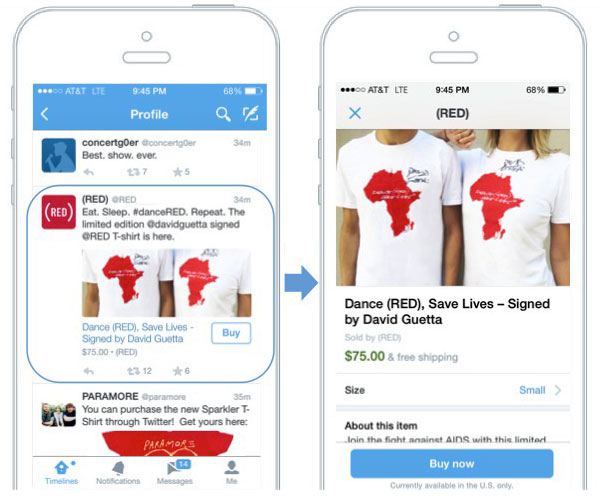Twitter on Monday began testing a new Buy button with a small percentage of its users in the U.S. — one of the first steps in a larger initiative to build purchase functionality into the service.
A small group of brands, including Burberry, Home Depot, Keith Urban, the Nature Conservatory and Soundgarden, are participating by sending offers that are unique for Twitter users.
Twitter partnered with Fancy (@fancy), Gumroad (@gumroad), Musictoday (@Musictoday) and Stripe (@stripe), using their platforms for the initial test. More partners will follow shortly.
What the user does is tap the Buy button to receive additional product details. Then, to make a purchase, the user enters shipping and payment information at the prompts. The payment and shipping information is encrypted and stored after the first transaction, so the user can make a purchase again without having to re-enter that data.
For sellers the advantage of the Buy button is clear: They are provided with a straightforward way to turn relationships they have built with followers over the years into sales.
Not a Public Utility
Twitter will gain similar benefits, although some users surely will object.
Twitter has been offering ad opportunities to brands for some time. It also began posting a profit this year, driven in large part by its mobile ad revenue. What the Buy button represents, however, is a shift in business strategy to include e-commerce.
Twitter has the right to monetize the torrent of tweets that flow daily through its application, said Rich Hanley, associate professor of journalism at Quinnipiac University.
“It is not a public utility,” he told the E-Commerce Times. “Will there be blowback from the Internet community? Yes. Will they stop tweeting? No. Facebook survived sponsored posts, and Twitter will survive the insertion of a Buy button even if it makes transparent the fact that it is a company that exists to make a profit.”
Still, the Buy button will be an intrusion into what was a content-centric and socially oriented service, Ben Hordell, a partner at DXagency, told the E-Commerce Times.
“Brands will need to be extra careful in how and when they use it,” he warned.
Users tend to stay with Twitter once they sign up to follow a brand or person. There are far fewer “unfollows” on Twitter than there are on Facebook, Hordell noted.
“This could change that,” he said.
Twitter will have to be very careful walking that line, Hordell continued — “being revenue- and advertiser-friendly, yet still appearing to be all about the consumer.”
A Branding Play
Another challenge for Twitter is that it is a tool seen mainly as a branding mechanism and not a sales generator, according to a recent survey conducted by Social Media Marketing University.
Of the 1,112 brands surveyed, 58 percent used Twitter to drive traffic, and 55 percent used it to engage existing customers. Only 24.4 percent used it to drive sales.
This is not exclusively a Twitter challenge, though. In general, social commerce has met with limited success.
Many initiatives have been tried and quietly shelved. Some have managed to slog along, but in general it has proven difficult to leverage a social network’s followers into direct sales. Companies have stopped trying, though. Facebook is testing its own Buy button as well.
However, as it moves into e-commerce, Twitter does have a natural advantage that Facebook doesn’t have.
It is the perfect medium for just-in-time purchases, Adam Root, CTO of SocialCentiv, told the E-Commerce Times.
“Twitter can already target ads by keywords contained in a tweet,” he pointed out, and a Twitter Buy button is sure to increase sales.”













































Social Media
See all Social Media